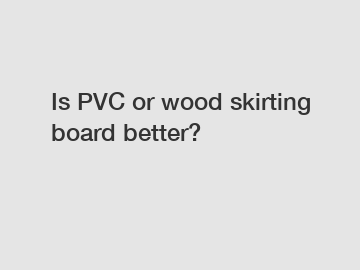Is PVC or wood skirting board better?
Is PVC or Wood Skirting Board Better?
Skirting boards play an essential role in enhancing the aesthetic appeal of any interior space. Not only do they provide a seamless transition between the walls and the floor, but they also protect the walls from accidental knocks and scuffs. When selecting skirting boards, one of the primary considerations is the material. PVC and wood are two popular options. In this article, we will examine the pros and cons of each material to determine which one is better suited for your needs.
PVC Skirting Boards.

PVC (Polyvinyl Chloride) skirting boards are made from a durable, synthetic plastic material. They are known for their cost-effectiveness and low maintenance. Here are the key advantages and disadvantages of PVC skirting boards.
Advantages of PVC Skirting Boards.
1. Durability: PVC skirting boards are highly resistant to wear and tear. They do not warp or crack over time, making them an excellent long-term investment. Additionally, PVC is moisture-resistant, making it suitable for areas prone to dampness or humidity, such as bathrooms and kitchens.
2. Low Maintenance: PVC skirting boards are incredibly easy to clean. Unlike wood, they do not require regular sanding, painting, or staining. Simply wipe them down with a damp cloth, and they will maintain their appearance for years to come.
3. Versatility: PVC skirting boards are available in a wide range of designs and finishes. They can easily mimic the look of wood, offering a more budget-friendly alternative with comparable aesthetics. Whether you prefer a classic or contemporary style, PVC skirting boards can complement any interior design.
Disadvantages of PVC Skirting Boards.
1. Visual Appeal: While PVC skirting boards replicate the look of wood, some people find that they lack the authenticity and charm of natural materials. If you value the warmth and natural grain pattern of wood, you may find PVC skirting boards less appealing.
Wooden Skirting Boards.
Wooden skirting boards, on the other hand, have been a popular choice for many years. Here are the advantages and disadvantages of opting for wood as your skirting board material.
Advantages of Wooden Skirting Boards.
1. Authenticity: Nothing can quite match the natural beauty and authenticity of wood. Wooden skirting boards provide a warm and inviting atmosphere, giving a touch of elegance and sophistication to any room. They also age gracefully and can be sanded and refinished to maintain their appearance.
2. Variety: Wood offers an extensive range of options in terms of species, finishes, and profiles. From oak to pine, you can choose the wood that best suits your style preferences. Additionally, wooden skirting boards can be stained or painted in any color to match your interior design scheme.
Disadvantages of Wooden Skirting Boards.
1. Higher Maintenance: Wood requires more maintenance compared to PVC. It needs to be regularly sanded, painted, or stained to protect it from moisture damage and keep it looking its best. This extra effort and cost can be a deterrent for some individuals.
Closing Paragraph.
In conclusion, both PVC and wood skirting boards have their own set of advantages and disadvantages. PVC is more affordable, durable, and low maintenance. On the other hand, wood offers unmatched authenticity, variety, and visual appeal. Ultimately, your choice will depend on your personal preferences and budget. If you are seeking a cost-effective and hassle-free option, PVC may be the better choice. However, if you value the timeless beauty of natural materials and are willing to invest extra time and effort in maintenance, wooden skirting boards are a fantastic choice. For more information or assistance in selecting the right skirting boards for your home, please don't hesitate to contact us.
For more information, please visit vinyl floor skirting, plastic skirting board to hide cables, roomline skirting.


